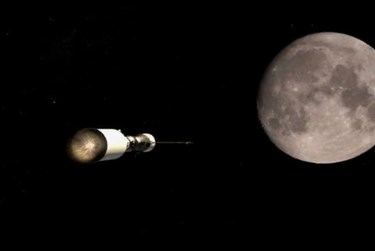
Illustration of a Soyuz spacecraft and habitation module en route to the Moon for a circumlunar flight Space Adventures has proposed.
A decade after the flight of Dennis Tito, widely if not universally acknowledged as the first space tourist, the company than brokered his flight sees a bright future ahead for commercial human spaceflight. In a teleconference with reporters on Thursday, Space Adventures chairman Eric Anderson said his company projects approximately 140 people to fly in space commercially in the coming decade. By comparison, during the last ten years seven people flew to space commercially on eight flights (one, Charles Simonyi, flew twice.)
Anderson said Space Adventures was asked by NASA and by Boeing (who Space Adventures has partnered with on development of a commercial crew vehicle, the CST-100) to provide an estimate on the demand for commercial human orbital spaceflight. That figure, he said, includes direct sales to individuals (the traditional “space tourist”) as well as lotteries and other competitions, corporate research, and educational missions. Anderson said the total specifically excludes what are often called “sovereign clients”, representatives of national space agencies flying for their governments. Those 140 people, he said, would fly to the ISS as well as Bigelow Aerospace facilities and one proposed by a Russian company, Orbital Technologies. “Realistically, having 140 individuals fly by the time 2020 rolls around is a pretty darn big accomplishment,” he said.
That estimate uses some relatively conservative assumptions on factors such as price and training time, Anderson said later. “For the majority of the next ten years, we would see prices roughly where they are now,” between $20 million and $50 million, he said. Price, he said, is probably the most important factor in demand, and there would not be dramatic changes in prices unless there was the development of a fully-reusable vehicle. Training time, he said would likely be no less than two months even for missions not going to the ISS. “I just don’t see a way to get that training time down any less than, say, six weeks,” he said. “There’s just too much stuff people need to know, they need to learn, in order to be prepared for the weightless environment.”
The other major aspect of the Space Adventures call Thursday was to provide an update on their circumlunar plans. Earlier this year Anderson announced that the company had signed up one customer for its proposed mission at a cost of $150 million. Anderson confirmed that on Thursday, and added that the company had started negotiations for the second seat available on the flight. “We are hopeful that the contract for the second client, and therefore the total locked-in mission, will be signed and announceable by the end of the year,” he said. Once the mission is “locked-in”, Anderson said they believe they will be able to fly it in about four years, or as soon as the end of 2015.
Anderson didn’t disclose the identities of either the signed customer or the potential customer they’re currently in negotiations with. However, Anderson did note, intriguingly, that the signed customer is planning some kind of research during the flight. The mission of that customer, he said, “is actually really, really meaningful. It is something that is going to address an issue and a concept that is of great importance to the world.” That work, which Anderson did not elaborate upon, will be “an amplifier to the attention” that circumlunar mission would receive and would “captivate a lot of people”.
Space Adventures also released some new images of the lunar mission concept, which features a habitation module launched separately on a Proton that would dock with the Soyuz spacecraft after the Soyuz completes a mission at the ISS. The hab module, along with the Soyuz modules, would provide 18 cubic meters of habitable volume for the three-person crew and would allow for “an extraordinarily comfortable trip to the Moon and back,” in the words of Richard Garriott, Space Adventures vice-chairman who flew to space as a customer of the company in 2008.
“We’re at an extraordinarily unusual moment in history,” Garriott said. “I good argument can be made that there’s every real possibility that the first human return to the Moon since the original Apollo flights may not be sponsored by any government of the Earth, but will be sponsored by private citizens.”

It will indeed be a great adventure to once again see man heading out to the lunar environment. Its been way to long. Let us hope this mission goes asap.
HOPE to BE tha first brazilian Team Member to circunavegate moon.
I am working very hard to BE the first one to fly SubOrbital flght.
Congratulations!!!